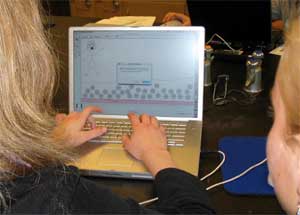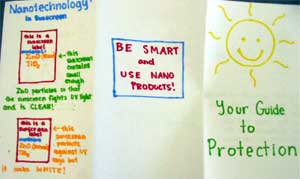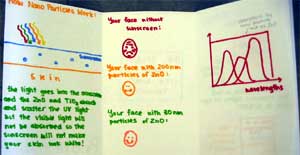Forum on Education of The American Physical Society
Summer 2006 Newsletter
|
NanoSense: Introducing High School Students to Nanoscale Science Patricia Schank and Alyssa Wise NanoSense (nanosense.org) is one of a few innovative programs addressing the question of how to teach nanoscale science at the high school level. Working closely with scientists and educators, we are creating, classroom testing, and disseminating curriculum units to help high school students understand science concepts that account for nanoscale phenomena and integrate these concepts with core scientific ideas in traditional curricula. As part of our participatory approach, we have also hosted two national workshops to bring together leading experts and practitioners in nanoscience and science education to identify and elaborate core concepts and learning goals for nanoscience education (see http://nanosense.org/workshops.html). Using the design features shown in the Table as our framework, we have developed and tested two units:
Each unit includes lesson plans, essential questions to drive learning, active learning experiences (labs, visualizations), student and teacher readings, slide presentations for class discussion, worksheets, quizzes, and performance assessments. Units in development focus on how nanoscience could advance energy production (Clean Energy) and water treatment (Fine Filters). Table. Key design features and their use in NanoSense units
Based on our experiences designing and testing NanoSense units, we have identified three main challenges and implications for developing nanoscience curricula. Challenge 1: Defining the Curriculum. Agreeing on a few central concepts through discussion and debate is an important first step in making sure that curricula meet the needs of the many stakeholders involved. Another issue is how to organize the curriculum: should it be topically based around applications, organized by underlying themes, or structured around content topics within traditional scientific disciplines? Our work suggests that organizing units around content topics helps students connect their prior knowledge to the new information. A third issue is finding reliable and verifiable information in a rapidly evolving area. For example, in the literature we found numerous terminology differences and explanations that contradicted each other on various fronts regarding whether zinc oxide blocks UV radiation by absorbing or scattering the radiation. There are few common frameworks for understanding emerging science--particularly ones that are understandable at a high school level. Challenge 2: Situating the Science. We are targeting our materials for high school chemistry, but knowledge of physics and biology are quite helpful for both teachers and students in understanding nanoscience and its applications. This raises the question of whether nanoscience is best taught toward the end of the general high school science sequence. Team teaching approaches could also be effective, but coordinating such efforts adds another layer of complication. Another approach is to leverage student knowledge of other disciplines, which could also reduce some of the burden on the teacher. A final issue is how to help teachers determine where the curriculum fits with what they currently teach. We have found it useful to provide teachers with alignment charts of where the curriculum addresses core science topics. Providing teachers with multiple ways to use the materials and a "drill-down" structure for progressively greater depth of understanding enables adjustment for different levels of students. Challenge 3: Preparing Teachers. A final challenge is developing teacher support materials for an area in which the content reaches outside teachers' expertise. Lack of familiarity with the content made it difficult for our teachers to stimulate discussion by asking follow-up questions and to identify and address student misconceptions. Developers must create materials that provide deep explanations, provide strong guidance for discussion topics and questions, and identify and highlight potential misconceptions. The novelty of the content, combined with the newness of the field, raises pedagogical demands that some teachers may not be prepared to deal with. Teachers are not able to know all the answers to students' (and their own) questions, and many questions go beyond our current understanding as a scientific community. To help teachers engage these challenges, we have recast them as opportunities to model the scientific process and provide concrete strategies for how to do so (see Figure 1). In this way, we aim to have teachers and students experience science in action as an empowering and energizing experience rather than as an exercise in frustration. Teachers receive a stipend, in addition to funding for travel, housing, professional development, and purchasing lab equipment for their classrooms. The commitment goes far beyond time during the summer, as teachers are expected to collaborate during the school year. Excerpt from teacher's guide addressing pedagogical challenges of teaching nanoscience
Despite these challenges, it is possible to introduce emerging science at the high school level. Cutting-edge science topics can engage students, reinforce core science concepts, and give students a better idea of how the traditional disciplines tie together. NanoSense units are available at nanosense.org, and we invite you to use them and send us feedback to improve the materials.
Students testing the UV blocking ability of a sunscreen
Acknowledgement NanoSense is supported by NSF Grant No. ESI-0426319. Any opinions, findings, and conclusions or recommendations expressed in this material are those of the authors and do not necessarily reflect the views of the National Science Foundation. Patricia Schank (patricia.schank@sri.com) is a research computer scientist at SRI International and principal investigator of the NanoSense project. Alyssa Wise (afwise@indiana.edu) is a doctoral student in the Learning Sciences program at Indiana University's School of Education. |
||||||||||||||||||||||||





